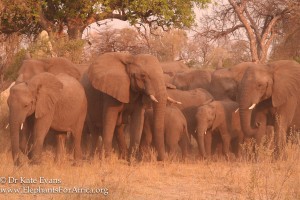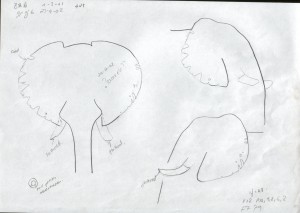
Training in the bush for NYC MARATHON
November 21, 2009
Poop to tell the tale
November 27, 2009A day in the life of a researcher
The dawn chorus wakes me, a cacophony of bird song taking over from the noises of the night. I am keen to get out and about as I heard trumpeting in the early hours of the morning, there was a herd of elephant around somewhere. I head north up towards our Picnic Site and find them.
I spotted the young males first, hanging out at the back sparring and greeting each other. With binoculars, notebook and camera to hand I set about gathering data, trying to identify who is who from their ear notches, tusk shape and over all body shape. I age them through an  estimation of height and when they have moved out of the area and it is safe to, I measure their foot prints as this is a good indication of height and therefore a good of age. I chose one young males who I have not knowingly sampled before and carry out a focal on him. This entails watching him for half an hour, noting what he eats, who he interacts with and who is closest neighbour. During the focal the rest of the herd move past and I try to take photos, sketch ears, estimate age and sex them as they pass to get an idea of the herd dynamics. I focus on the adult females, as if I can identify one of them I will have an idea of which herd it is and therefore whom to expect to see with her.
estimation of height and when they have moved out of the area and it is safe to, I measure their foot prints as this is a good indication of height and therefore a good of age. I chose one young males who I have not knowingly sampled before and carry out a focal on him. This entails watching him for half an hour, noting what he eats, who he interacts with and who is closest neighbour. During the focal the rest of the herd move past and I try to take photos, sketch ears, estimate age and sex them as they pass to get an idea of the herd dynamics. I focus on the adult females, as if I can identify one of them I will have an idea of which herd it is and therefore whom to expect to see with her.
I do not recognise any of them straight off and so identification will have to wait until I am back in camp and can download the photos. Digital photography has really speeded things up, as when I first started the project in 2002 I would have to wait for three months until I went into town to take all the films to be developed and would then take days to sort through them all. It was expensive, both monetary and with time.
After about an hour, the elephants start to move off, melting into the landscape as quick as they had appeared. I had counted more than 50 elephants, which is a large herd for this area. One young male is left behind, still happily feeding away on the Mopane, he soon realises he is alone and trots off, but not before coming closer to inspect me – ears and trunk raised. He is a confident little chap and comes up to the car – trunk out stretched, gathering information through smell, sight and sound as to who I am. His confidence thrills me, he does not see me as a threat, rather as a curiosity. Here in the Okavango delta the elephants rarely come into contact with humans and therefore have no reason to fear us, if we are quiet and respect their space.
As the last elephant disappears into the forest I carry on the route I was on, I do not see any more elephants, but plenty of birds and game. Even when I have a day and I don’t see a single elephant there is always plenty of other things to catch your attention and I learn something new everyday.
I then go in search of one of our collared elephants, that have been released from the herd at Abu Camp. I quickly pick up the signal from Nandipa’s collar and go off in pursuit. I find her three kilometres away, enjoying a mud bath with her young male calf, Ntongine. She was released from the herd in September 2003 and since then has taught us a lot about the female social system and the importance of relationships. Whilst she has spent time with herds, she has never become integrated into one of them and flits between them. The arrival of Ntongine in May 2006 was the epitomy of what we are trying to achieve with the releases, to see if captive elephants can be released back into the wild. Successfully reproduction is often cited as a characteristic of successful release – so she has achieved that. For the three young males that have been released, we shall have to wait a lot longer to see if they are successful reproducers. To gauge the success of their releases I look at their social interactions and social groupings and compare them to wild bulls of a similar age. By the time I have gather the information I need on Nandipa and Ntongine it is time for lunch and so I head back to camp.
After a quick lunch I get on with the identification of all the elephants I have seen that morning, downloading the photos and looking for similar ears in amongst the >700 ID sheets we have in camp that have been collected over the 7-years the project has been running. It is a laborious process but when you ID one of them it is very rewarding. Over time I hope to be able to deceiver the subtle relationships between the males and who they like to hang out with.
Come 1600, the heat of the day is dissipating and it is time to go out again. I am keen to find the released male Thando who is out west. Soon I won’t be able to find him from the ground as the flood waters will arrive and cut me off from that section of the Delta. It takes an hour to get out there, but it has been worth it as Thando is with a herd. More frantic note taking, focal observations and photographs, and I have created more computer work for me when I get home in the evening. It is no bother as over time we shall understand the period of adolescent males a little better. On the way home, the sunsets and the bush noise change once again from diurnal to nocturnal and I keep my eye open for the elusive leopards.

